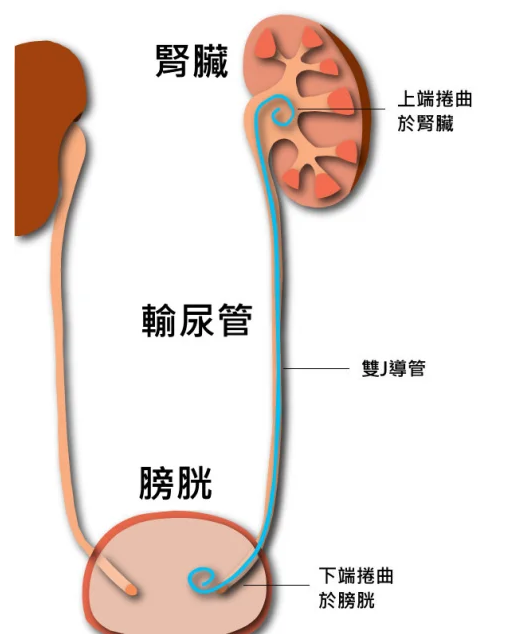[Learning Points]
- The double-ended J-shaped tube is usually placed into the ureter through the urethra with an endoscope. One end is left in the renal pelvis and the other end is stuck in the bladder to prevent it from moving.
- It is mainly used to treat or prevent ureteral stenosis, place double-ended J-shaped tubes after lithotripsy and other conditions when necessary. Due to damage to the urethral mucosa, there may be hematuria, slight backache, low back pain, and lower abdominal pain, especially when urinating.
- The double-headed J-type tube is usually left in place for two to three weeks, but no more than three months at most. The doctor will notify you to return to the hospital, perform local anesthesia in the outpatient operating room, and use a cystoscope to remove the tube to avoid leaving it for too long, resulting in Adhesion or stones occur.
What is the double-J catheter
A hollow tube which is shaped at both ends like a word “J”, usually is placed within the ureter through the urethra under the vision of endoscope. If it is difficult to be indwelled through urethra, it could be placed through the percutaneous route. One end is left within renal pelvis, and the other is hooked within the urinary bladder. It prevents the double J catheter from dislodgement. The catheter is externally invisible from the naked eyes.When to place double-J catheter?
- Treat or prevent the stenosis or stricture of ureter.
- After ureteral reconstructive procedure.
- After ureterorenoscopic lithotripsy or percutaneous nephrolithotomy procedure
- After undergoing ureteral anastomosis.
- Depending on the disease characteristics and patient’s factors.
Objective
- Dilate the ureter, keep the ureter patent and relieve obstructive hydronephrosis.
- Prevent stone fragments or blood clots to occlude the ureteral lumen, causing obstruction, pain and urinary tract infection after urotract procedure.
- Prevent urine leakage from reconstructive site or injured site and facilitate healing of ureteral wound.
What are bothersome symptoms or signs with double J catheter in place?
Double J catheter might irritate the urinary bladder, causing irritative symptoms (frequency, urgency, etc. ), hematuria, lower abdominal pain or discomfort, especially when voiding.Management
- The dwelling time of the double J catheter is variable, depending on the disease status and associated procedures. The duration is approximately two to three weeks, and the longest dwelling time is usually not more than three months. The urologist will make appointment for outpatient follow-up visit. The removal of double J catheter under the local anesthesia will be scheduled if overdue or stone burden decreasing or stone free. Generally, urologists avoid keeping the double J catheter within patient’s body too long to get stuck or encrust stones along the catheter.
- After stone procedures, plain X-ray film would be taken to check the position of double J catheter and residual stone burdens. Doctor will consider to remove double J catheter, depending the disease status and/or stone-free status.
Warning notice on double J catheter within the patient’s body.
If you have double J catheter within your body, the medical or nursing staffs will give you advice.
- Drink at least 2000-3000 cc water a day, including juices and soups, if no contraindication (such as renal or heart problems), to prevent urinary tract infection. You do not change dressing because of “no wound “.
- Do not hold urination. When you hold voiding, the urine within the urinary bladder might reflux up to the kidney through double J catheter. It will increase the chance of urinary tract infection.
- Avoid increasing abdominal straining, such as constipation, heavy lifting, and so on, to prevent double J catheter migrating.
When you should come back
- Visible gross hematuria.
- Severe abdominal discomfort, even with medications.
- Fever (up to 38°C, chills).
- Burning sensations and turbid urine.
Conclusion
The role of the ureteral double-J catheter is to drain urine to the bladder, but it is often accompanied by backache and slight pain. As long as you drink plenty of water, reduce abdominal pressure, and avoid urine reflux, your double-J catheter can solve the problem.
The role of the ureteral double-J catheter is to drain urine to the bladder, but it is often accompanied by backache and slight pain. As long as you drink plenty of water, reduce abdominal pressure, and avoid urine reflux, your double-J catheter can solve the problem.
References
- Lee, S.W., Hsiao, P.J., Chang, C.H., Chou, E. C. L.(2019). Lower urinary tract symptoms associated with double-J stent. Urological Science, 30(3), 92-98.https://doi.org//10.4103/UROS.UROS_56_18.
- Wu, M. S.、Jhang, J. Y.(2021). Nursing care of patients with ureteral stone undergoing ureterorenoscopic lithotripsy.Journal of National Taichung University of Science and Technology, 8(1), 85-96. https://doi.org//10.6902/JNTUST.202112_8(1).0005
簡易測驗
Let's take the quiz to make sure you understand
評語
統計結果不開放
請登入後才可以評分
未登入或權限不足!
- 位置
-
- 資料夾名稱
- English
- 上傳者
- 魏方君
- 單位
- 中榮護理衛教
- 英文名稱
- Care Notice of Ureteral Double-J Catheter
- 分類
- 出院照護
- 科別
- 英語
- 癌症照護
- 否
- 建立
- 2024-02-26 17:00:12
- 制訂日期
- 2019-04-19
- 最近修訂
- 2024-03-26 19:25:00
